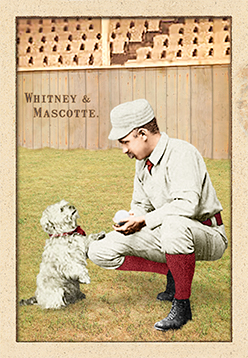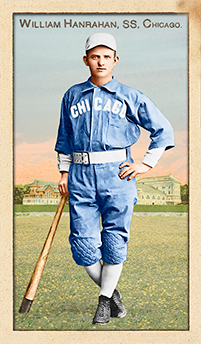
- Series: 1880s: Diamond Duos
- City: New York
- Team: Giants
- League: National League
Art Whitney:
Arthur Wilson Whitney (1858-1943). Art played 3rd base for 8 different teams over 11 major league seasons. A below average hitter, his best year may have been 1886 with the Pittsburgh Alleghenys when he compiled 122 hits, 13 doubles, 4 triples, 15 steals & 70 runs with a light .239 batting average.
- 2x World Series Champion with the New York Giants: 1888 & 1889
- Although I haven't quite figured it all out, it appears Whitney was part of a fairly distinguished baseball family. His brother Frank played for the Boston Red Stockings in 1876; Charles Whitney, who played minor league ball from 1879 to 1889, was also likely Art's brother; and research suggests that 10 year major league veteran Grasshopper Jim Whitney may have been a cousin.
Mascotte:
This dog's name and relationship to Art Whitney and/or the New York Giants has been lost to history. I have no evidence that this dog ever served as the team's mascot, but she does appear to be wearing a handkerchief in the team's colors. The Giants (Buck Ewing in particular) were notoriously superstitious about their mascots. At one time or another between 1884 and 1890, the Giants "employed" at least five children: Masters Boldt, Bretsie, Preston, Breslin and an unidentified "colored boy," a yellow mongrel dog who was eventually captured by animal control and euthanized, and a toy rubber dog that barked when squeezed.
Despite the mystery surrounding this dog, her presence and photogenic posing created what REA has described as "one of the most unusual and memorable images to ever appear on a baseball card." It has been suggested that this image was staged and intended by the Goodwin photographers to represent a sort of comedic complex irony. Between the minor and major leagues, Art Whitney played for 12 different teams over 17 professional seasons and twice sued his team in contractual disputes. Even in an era when few players stayed with any one team for more than a year or two, Whitney's lack of loyalty was possibly renowned and cast into stark contrast in this photo by the adoring attention he is being given by man's best friend, the ever-loyal dog.
Whether the meeting between the two was devised or a genuine moment in time caught by a Goodwin photographer, I think the image's appeal is due to something simple we can all relate to: it's fun.
In fact, this is perhaps the image that most directly inspired the idea behind the Ars Longa 1880s series. In the nascent stages of my work, when this was all but an amorphous and rudimentary idea, I saw this image and thought how fun it would be to colorize it. Three and a half years and nearly 750 cards later, here it is.
Auction History
Cartophilia
Old Judge Pose: 499-1

- Series: Beginnings: 1880's
- City: Chicago
- Team: White Stockings
- League: National League
Charles Wellington Sprague (1864-1912) pitched for nine teams from 1887 through 1891, three of which were in the major leagues: the National League’s Chicago White Stockings and Cleveland Spiders, and the Toledo Maumees of the American Association. His other experience was primarily in the Western Association with Jamestown of the New York-Pennsylvania League being his final stop. With the big clubs, Sprague had a respectable 10-7 record during three seasons with a 4.51 ERA. The lefty played a little outfield when not on the mound. For Toledo, Charlie was the fourth starter with Egyptian Healy being the ace. The team finished fourth in 1890, the year so many stars bolted to their start-up “Players’ National League of Professional Base Ball Clubs” (aka the Players’ League or “Brotherhood.”)
- The Goodwin guide editors note that Charlie’s Old Judge images are unusual in depicting him in two different team uniforms in the same season: Chicago’s White Stockings and Maroons in 1888

- Series: Beginnings: 1880's
- City: Chicago
- Team: White Stockings
- League: National League
William T. Hanrahan, nicknamed “Red,” played minor league ball from 1885 through 1898, primarily in the Western Association and the Eastern League. He began with Albany of the New York State League but moved west to Chicago in 1888, presumably to make his bid to play major league baseball in the National League.
The shortstop was photographed by Old Judge that year in a Chicago White Stockings uniform. However, Red never played for the team and is identified by Goodwin instead as a member of the Chicago Maroons in 1888 and the Minneapolis Millers in 1889. This makes Red one of a handful of Old Judge subjects who was lucky enough to be on a major league roster the day the Goodwin photographers showed up, but unlucky enough to be removed from the roster without ever having played a game for that or any other major league team. So close, Red! So close.
Red was a regular with both the Maroons and Millers, playing in over a hundred games for both clubs. The sketchy minor league stats don’t record every campaign, but he seems to have generally batted under .300, faring better in the 1890s when he returned east. He hit .307 with Albany in ‘93 and .306 with Rochester in ‘96. By then his plate appearances were in decline, getting into only 16 games with the Browns. Red’s final season brought his pro ball career full-circle as he wrapped it up with the Johnstown/Palmyra Mormans (aka Johnnies) of a newly reconstituted NY State League in 1898, which now included Pennsylvania teams.
- The Maroons and Millers were led by manager Moxie Hengel, the only two seasons he managed in pro ball. With Minneapolis, Moxie shared managerial duties with Sam Morton. It is said the two had a strange method, Hengel piloting the road games and Morton serving as the home field boss
- As a rule of thumb in the 1880s series, I always designate a player’s team as that for which he is uniformed in the photograph, even if he never played for the team.

- Series: Pioneer Portraits II: 1875-1899
- City: Chicago
- Team: White Stockings
- League: National League
Eliza G. Green Williams Brown Daggett (1851-1926) was hailed in her hometown in 1920 as “the woman who has made Attleboro famous.” As the first female in the Bay State to seek mayoral office, Eliza was, indeed, noteworthy. But it was her surreptitious labors for Al Spalding under her maiden name that earned her a place in the annals of baseball as well as politics.
Al Spalding's White Stockings (Cubs) had many a fractious player - “kickers” in the jargon of the day. Spalding needed someone to bring a sane, objective and expert eye to the task of recording for posterity the hits, errors and miscellanea of the club's performance; someone impervious to the importuning of players lobbying for favorable rulings from the scorekeeper. He found what he needed in a lady who lived across from the ballpark, a woman who was an avid fan and an inveterate record-keeper. Eliza scored every home game and she had the cool, detached manner of a secret agent. Spalding recruited her to be his anonymous official scorer and, for a decade (1882-91), Eliza sat with the players' wives, keeping meticulous score and passing judgement on hits and errors - even settling player arguments - but never betraying her professional role. The National League officials to whom Eliza dispatched her score cards never knew that “E.G. Green” was a woman, allowing Spalding to avoid the scandal that would have ensued had it been known that a woman held such an important job in the sports world of Nineteenth Century America.
- Eliza was able to avoid detection completely, even from club-omniscient captain Adrian Anson, despite the fact that Eliza usually performed her duties while sitting beside Anson's wife.
- Apparently, Eliza kept the secret even from her family. Her son Charles recounts that he would mail the scorecards to Major League Baseball for his mother, without ever knowing the contents or purpose of the packages.
- Daggett was a devoted suffragist, a friend of Susan B. Anthony, and a tireless campaigner for the Republican Party long before seeking office for herself
- Her son Charles Williams was team treasurer for the Cubs during their championship season of 1908

- Series: Beginnings: 1880's
- City: Detroit
- Team: Wolverines
- League: National League
Frank S. Scheibeck (1865-1956) enjoyed a two-decade career that began with the Duluth Freezers and ended with his hometown Tigers at age 41 in 1906. Frank had some distinguished moments over this long haul. With the Toledo Maumees of the AA in 1890, he was the league leader for shortstops in several defensive categories while hitting .282. His performance could careen up and down, however, leading to many assignments in the minors. Undoubtedly, Frank regaled his grandkids with the tale of his role in one of the greatest ninth-inning comebacks ever: a bases-loaded double that sparked his Cleveland Blues against the Washington Senators, overcoming a 13-5 deficit on May 31, 1901.
- Remarkably, on April 25, 1901 in their first American League game, Detroit overcame a ten-run disadvantage, also in the bottom of the ninth versus the Brewers
- Played for seven major-league teams from 1887-1906
- Played for three different professional baseball teams in Detroit across three different leagues: Detroit Wolverines, NL, 1888; Detroit Tigers, WL, 1895-96; Detroit Tigers, AL, 1906.




